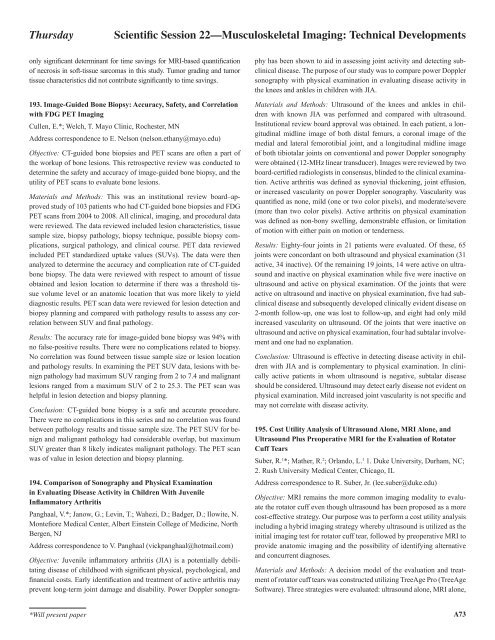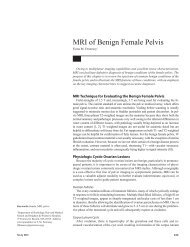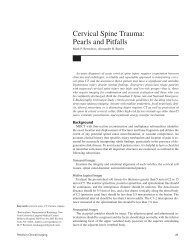Scientific Session 1 â Breast Imaging: Mammography
Scientific Session 1 â Breast Imaging: Mammography
Scientific Session 1 â Breast Imaging: Mammography
You also want an ePaper? Increase the reach of your titles
YUMPU automatically turns print PDFs into web optimized ePapers that Google loves.
Thursday<strong>Scientific</strong> <strong>Session</strong> 22—Musculoskeletal <strong>Imaging</strong>: Technical Developmentsonly significant determinant for time savings for MRI-based quantificationof necrosis in soft-tissue sarcomas in this study. Tumor grading and tumortissue characteristics did not contribute significantly to time savings.193. Image-Guided Bone Biopsy: Accuracy, Safety, and Correlationwith FDG PET <strong>Imaging</strong>Cullen, E.*; Welch, T. Mayo Clinic, Rochester, MNAddress correspondence to E. Nelson (nelson.ethany@mayo.edu)Objective: CT-guided bone biopsies and PET scans are often a part ofthe workup of bone lesions. This retrospective review was conducted todetermine the safety and accuracy of image-guided bone biopsy, and theutility of PET scans to evaluate bone lesions.Materials and Methods: This was an institutional review board–approvedstudy of 103 patients who had CT-guided bone biopsies and FDGPET scans from 2004 to 2008. All clinical, imaging, and procedural datawere reviewed. The data reviewed included lesion characteristics, tissuesample size, biopsy pathology, biopsy technique, possible biopsy complications,surgical pathology, and clinical course. PET data reviewedincluded PET standardized uptake values (SUVs). The data were thenanalyzed to determine the accuracy and complication rate of CT-guidedbone biopsy. The data were reviewed with respect to amount of tissueobtained and lesion location to determine if there was a threshold tissuevolume level or an anatomic location that was more likely to yielddiagnostic results. PET scan data were reviewed for lesion detection andbiopsy planning and compared with pathology results to assess any correlationbetween SUV and final pathology.Results: The accuracy rate for image-guided bone biopsy was 94% withno false-positive results. There were no complications related to biopsy.No correlation was found between tissue sample size or lesion locationand pathology results. In examining the PET SUV data, lesions with benignpathology had maximum SUV ranging from 2 to 7.4 and malignantlesions ranged from a maximum SUV of 2 to 25.3. The PET scan washelpful in lesion detection and biopsy planning.Conclusion: CT-guided bone biopsy is a safe and accurate procedure.There were no complications in this series and no correlation was foundbetween pathology results and tissue sample size. The PET SUV for benignand malignant pathology had considerable overlap, but maximumSUV greater than 8 likely indicates malignant pathology. The PET scanwas of value in lesion detection and biopsy planning.194. Comparison of Sonography and Physical Examinationin Evaluating Disease Activity in Children With JuvenileInflammatory ArthritisPanghaal, V.*; Janow, G.; Levin, T.; Wahezi, D.; Badger, D.; Ilowite, N.Montefiore Medical Center, Albert Einstein College of Medicine, NorthBergen, NJAddress correspondence to V. Panghaal (vickpanghaal@hotmail.com)Objective: Juvenile inflammatory arthritis (JIA) is a potentially debilitatingdisease of childhood with significant physical, psychological, andfinancial costs. Early identification and treatment of active arthritis mayprevent long-term joint damage and disability. Power Doppler sonographyhas been shown to aid in assessing joint activity and detecting subclinicaldisease. The purpose of our study was to compare power Dopplersonography with physical examination in evaluating disease activity inthe knees and ankles in children with JIA.Materials and Methods: Ultrasound of the knees and ankles in childrenwith known JIA was performed and compared with ultrasound.Institutional review board approval was obtained. In each patient, a longitudinalmidline image of both distal femurs, a coronal image of themedial and lateral femorotibial joint, and a longitudinal midline imageof both tibiotalar joints on conventional and power Doppler sonographywere obtained (12-MHz linear transducer). Images were reviewed by twoboard-certified radiologists in consensus, blinded to the clinical examination.Active arthritis was defined as synovial thickening, joint effusion,or increased vascularity on power Doppler sonography. Vascularity wasquantified as none, mild (one or two color pixels), and moderate/severe(more than two color pixels). Active arthritis on physical examinationwas defined as non-bony swelling, demonstrable effusion, or limitationof motion with either pain on motion or tenderness.Results: Eighty-four joints in 21 patients were evaluated. Of these, 65joints were concordant on both ultrasound and physical examination (31active, 34 inactive). Of the remaining 19 joints, 14 were active on ultrasoundand inactive on physical examination while five were inactive onultrasound and active on physical examination. Of the joints that wereactive on ultrasound and inactive on physical examination, five had subclinicaldisease and subsequently developed clinically evident disease on2-month follow-up, one was lost to follow-up, and eight had only mildincreased vascularity on ultrasound. Of the joints that were inactive onultrasound and active on physical examination, four had subtalar involvementand one had no explanation.Conclusion: Ultrasound is effective in detecting disease activity in childrenwith JIA and is complementary to physical examination. In clinicallyactive patients in whom ultrasound is negative, subtalar diseaseshould be considered. Ultrasound may detect early disease not evident onphysical examination. Mild increased joint vascularity is not specific andmay not correlate with disease activity.195. Cost Utility Analysis of Ultrasound Alone, MRI Alone, andUltrasound Plus Preoperative MRI for the Evaluation of RotatorCuff TearsSuber, R. 1 *; Mather, R. 2 ; Orlando, L. 1 1. Duke University, Durham, NC;2. Rush University Medical Center, Chicago, ILAddress correspondence to R. Suber, Jr. (lee.suber@duke.edu)Objective: MRI remains the more common imaging modality to evaluatethe rotator cuff even though ultrasound has been proposed as a morecost-effective strategy. Our purpose was to perform a cost utility analysisincluding a hybrid imaging strategy whereby ultrasound is utilized as theinitial imaging test for rotator cuff tear, followed by preoperative MRI toprovide anatomic imaging and the possibility of identifying alternativeand concurrent diagnoses.Materials and Methods: A decision model of the evaluation and treatmentof rotator cuff tears was constructed utilizing TreeAge Pro (TreeAgeSoftware). Three strategies were evaluated: ultrasound alone, MRI alone,*Will present paperA73
















